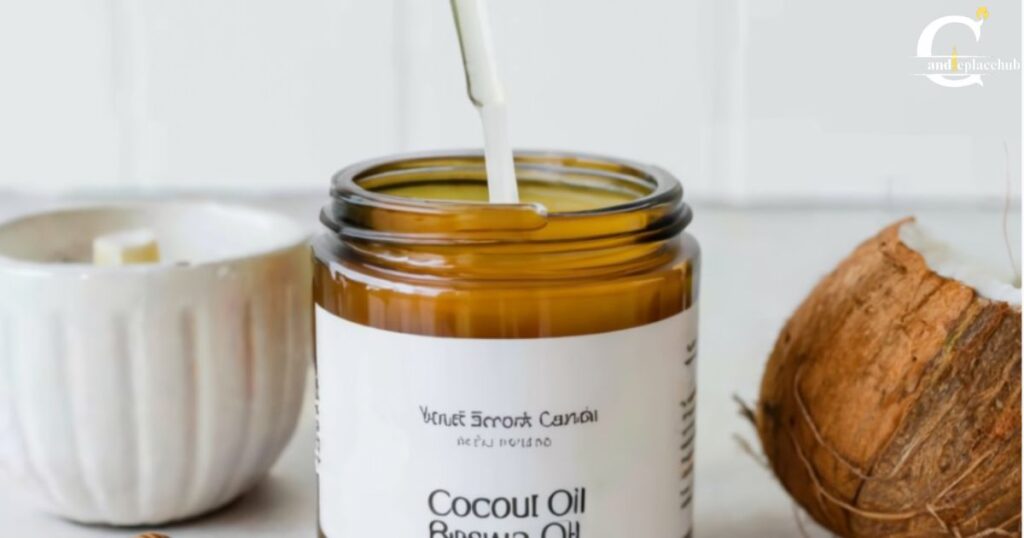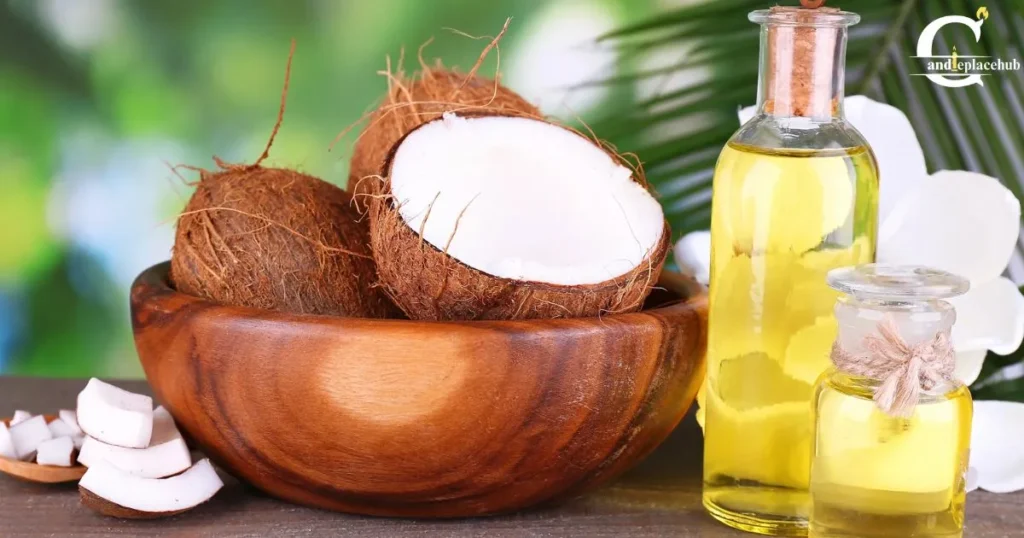Beeswax candles are special candles made from the wax produced by honeybees. It is a natural substance that bees create in their hives. To make these candles the beeswax is melted and shaped into candles. These candles have a sweet, natural scent and come in various shapes and sizes.
Adding coconut oil to beeswax candles is like giving them a superpower. Are you thinking about ‘Why Add Coconut Oil To Beeswax Candles?’ Mixing coconut oil with beeswax is like creating a magical candle that lasts longer and smells amazing. Stay tuned for why these candles glow nicely and create a lovely environment in your room. Feel the natural harmony and brightness all in one flame.
Imagine making a cake you have the main ingredients but adding a bit of extra sweetness makes it even better. In the same way combining coconut oil with beeswax improves the candle in a few ways. It makes candles burn better, smell nicer and easier to handle. It is like a little secret ingredient that makes everything better.
How much Coconut Oil should I add to Beeswax Candles?

Creating the perfect combination of coconut oil and beeswax for your candles can be a bit like a fun experiment. A good way to start is with a 50/50 mixture meaning equal parts of 1 ounce of coconut oil to 1 ounce of beeswax. This makes measuring easy and gives your candles a balanced consistency not too hard or too soft. But here is the exciting part you can play around with different ratios to find what suits you best.
If the wax feels too soft with the 50/50 mix you can try a 75/25 mixture where 75% is beeswax and 25% is coconut oil. It is like finding the perfect recipe for your favorite dish, trial and error is the key. So, feel free to experiment and discover the ideal blend that works perfectly for your unique candles. It is all about having fun and creating candles that you will love.
In addition to finding the right ratio of coconut oil to beeswax there are a few more tips to enhance your beeswax candles making experience:
Quality Matters
Use high quality pure beeswax and coconut oil for the best results. This ensures a cleaner burn and a more pleasant scent for beeswax candles.
Add Fragrance
If you want to add a delightful fragrance to your candles consider incorporating essential oils. Just a few drops can transform your candles into a personalized aromatic experience.
Wick Selection
The type and size of the wick also play a role in the candles performance. Experiment with different wick materials and sizes to find the one that suits your mixture best.
Double Boiler Method
Melt the coconut oil and beeswax using a double boiler to prevent overheating. This gentle method ensures a smooth and consistent blend to beeswax candles.
Patience is Key
Allow the candles to cool and solidify properly before lighting them. This patience ensures a longer lasting and more even burn.
What type of Coconut Oil is best for Candles?

Choosing the right coconut oil for candles is important for a great candle making experience. Look for virgin coconut oil as it retains its natural scent and color.
Make sure it is unrefined and cold pressed as this preserves its beneficial properties. Opt for a coconut oil with a lower melting point around 76 degrees Fahrenheit (24 degrees Celsius) for a smoother and even burn. Lastly check for oil labeled as “odorless” if you prefer a neutral base for adding fragrance to your candles.
The Environmental Impact of Beeswax Candles
When beeswax candles burn they clean the air like magic. It is because they make something called negative ions that stick to bad things in the air like dust and nasty stuff.
Beeswax candles are great for making at home. They don’t need any weird chemicals and they smell nice in a simple way. Unlike some other candles made from things like petroleum which is not good for the Earth.
The fancy candles that made from paraffin wax or gel wax they are not eco-friendly because they come from leftover stuff used for cars. If you are wondering how to light a candle without a lighter there are alternative methods such as using matches, a stove or even a toaster for a creative and resourceful approach.
But if you mix beeswax with coconut oil it is like making the best natural candles. They don’t just smell good, they are good for the planet too.
Simple steps to make Beeswax and Coconut Oil Candles

Materials
- 1 pound 453 grams of beeswax pellets
- 1 cup 240 ml of coconut oil
- Candle wicks pre-tabbed or cut to desired length
- Essential oils (optional)
- Containers ‘jars or tins for candles’
Tools
- Double boiler or a heat resistant bowl and pot for melting
- Stirring utensil
- Measuring cup
- Thermometer
- Wick holder
- Scissors for trimming wicks
Instructions
Prepare Work Area:
Set up a clean and organized work area. Cover surfaces to catch any potential spills.
Measure Ingredients:
Weigh 1 pound 453 grams of beeswax pellets and measure 1 cup 240 ml of coconut oil.
Prepare Containers:
Choose the containers for your candles. Measure the diameter and height of the containers to determine the appropriate wick size.
Wick Placement:
Attach wicks to the bottom center of each container using a wick holder or a small amount of melted wax.
Melt Beeswax and Coconut Oil:
Use a double boiler or a heat resistant bowl placed over a pot of simmering water to melt the 1 pound of beeswax pellets and 1 cup of coconut oil. Stir occasionally until fully melted. Use a thermometer to monitor the temperature marking for around 170-180°F (77-82°C).
Add Essential Oils (Optional):
If desired add a few drops of your preferred essential oil to the melted wax and coconut oil mixture.
Pour Into Containers:
Carefully pour the melted wax and oil mixture into the prepared containers. Leave some space at the top.
Cooling and Solidification:
Allow the candles to cool and solidify completely. This may take several hours.
Trim the Wick and Enjoy:
Once the wax has solidified trim the wick to about 1/4 inch (0.6 cm) above the surface of the candle. Your homemade beeswax and coconut oil candles are now ready to be lit and enjoyed.
Safety Notes
- Be cautious when working with hot wax to avoid burns.
- Use a thermometer to monitor the temperature of the melted wax.
- Work in a well ventilated area specially if using essential oils.
- Follow safety guidelines for beeswax candles making and never leave burning candles unattended.
Benefits of Mixing Beeswax with Coconut Oil
Candles made by mixing beeswax with coconut oil bring lots of good things to your home. Let’s find out why they are so special
Natural and Eco-Friendly
Mixing beeswax with coconut oil creates a natural and eco-friendly candle. Beeswax candles are natural substance produced by bees while coconut oil is derived from coconuts. Combining them results in a candle that doesn’t contain harmful chemicals making it a safer and more environmentally friendly choice compared to some commercial candles.
Long-Lasting Burn
The blend of beeswax and coconut oil enhances the beeswax candles burn time. Beeswax has a high melting point and when combined with the slower burning coconut oil the candle lasts longer. This means you can enjoy the warm glow and nice scent for an extended period making it a cost effective and efficient lighting option.
Sets Up More Evenly
The mixture of beeswax and coconut oil allows the candle to set up more evenly. This means that as the candle cools and solidifies it forms a smooth and uniform surface. This not only enhances the beeswax candles appearance but also ensures a consistent and steady burn providing a more enjoyable and aesthetically attractive experience.
Prevents Tunneling
Tunneling is a common issue in candles where only the center of the wax burns down leaving the outer wax untouched. Mixing beeswax with coconut oil helps prevent tunneling by promoting an even burn across the entire surface of the candle. This ensures that you get the most out of your candle both in terms of appearance and functionality.
Cost Effective
It is a smart choice for your wallet. You can get good quality beeswax candles without spending too much money.
Soft and Smooth Texture
The combination of beeswax and coconut oil results in a candle with a soft and smooth texture. This not only enhances the overall beautiful appeal but also contributes to enjoyable tactile experience. As the beeswax candles burns it maintains its smooth surface creating a visually and physically pleasing addition to your home decoration.
Frequently Asked Questions
Can I use any type of beeswax and coconut oil?
You can use any kind of beeswax and coconut oil for making candles. Just make sure they are good quality and safe for candle making.
Do I need to add essential oils?
It is not necessary but if you want a nice smell you can add essential oils. They make your candles fragrant.
When should you add coconut oil to beeswax?
Add coconut oil to melted beeswax. When both are liquid mix them together. This helps in making the candle burn better.
Does coconut oil burn clean?
Coconut oil is known for burning cleanly. It is a good option for candles as it produces minimal smoke or soot.
Can you add fragrance to beeswax candles blended in with coconut oil?
If you want a scented candle you can mix in essential oils when combining beeswax and coconut oil. This will give your candle an enjoyable fragrance.
Final Thoughts
Adding coconut oil to beeswax candles is a good idea because it makes the candles burn better and smell nice. As we explore the question ‘Why add coconut oil to beeswax candles?’ Coconut oil helps the wax melt evenly so the candle lasts longer. It also gives a sweet and tropical scent making your room smell wonderful.
Coconut oil is good for the environment and your health. It comes from coconuts which are natural and renewable. When you burn a candle with coconut oil it doesn’t release harmful chemicals. This means you can enjoy a cozy environment without worrying about breathing in bad stuff. So adding coconut oil to beeswax candles is like giving your room a longer lasting hug with a pleasant smell and it is good for you.

Hi there! I’m Harrison Ford, a candle fanatic with 8 years of experience. Explore my website to discover the magic of candles through my passion filled journey, where I share tips, stories and everything you need to know about these glowing wonders.











